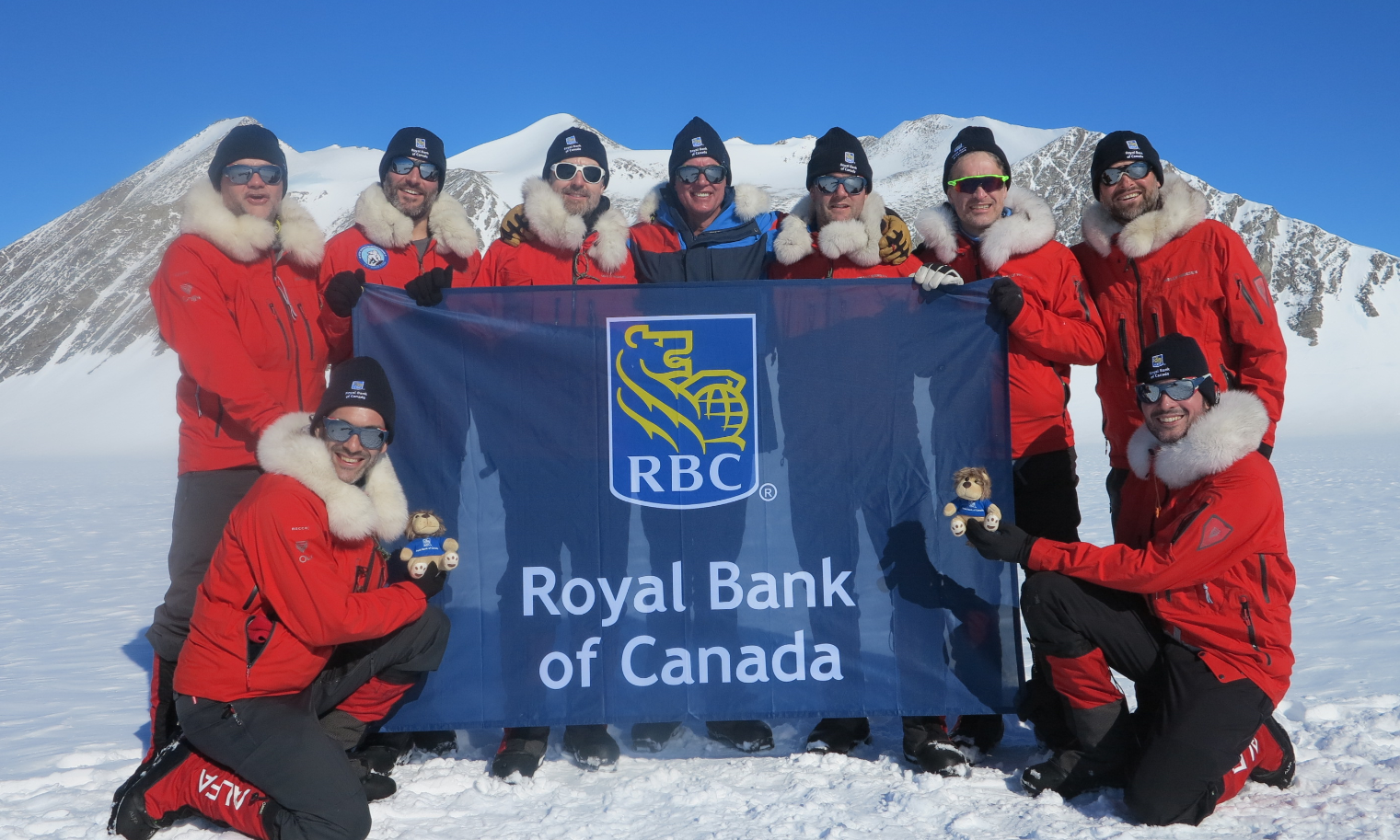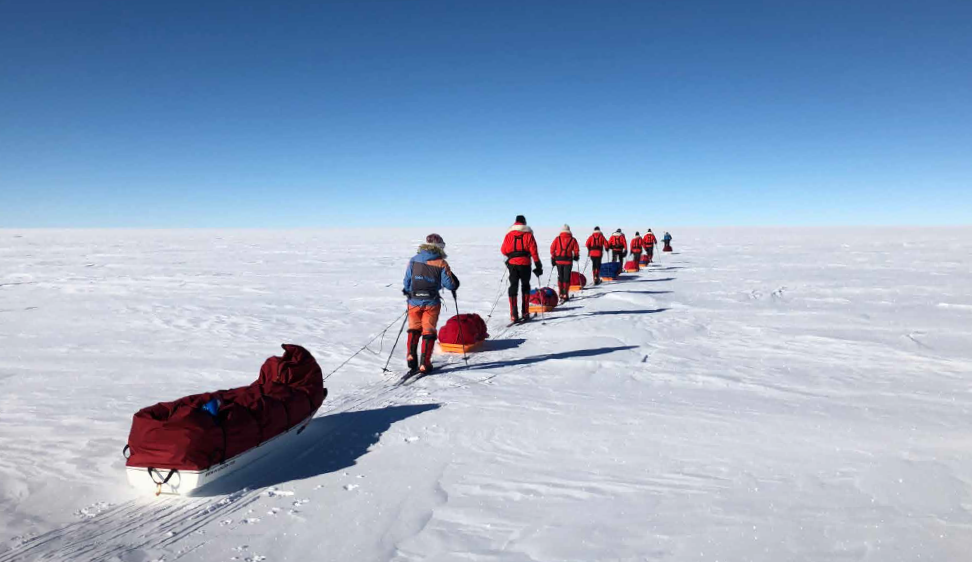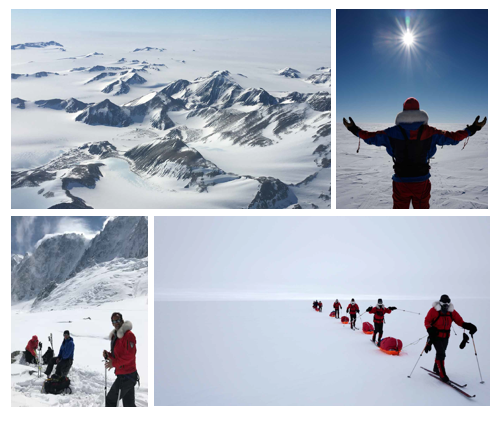
In late 2017, a group of nine London-based entrepreneurs and executives, including Ed Boyce, an RBC Managing Director, completed a self-supported trek to the Geographic South Pole and raised more than £1 million for two charities: The Prince’s Trust and The Roundhouse Trust. Both charities are committed to helping young people – particularly those from vulnerable or disadvantaged backgrounds – fulfil their potential by providing the right amount of support through encouraging belief and help them strive to be their best. This expedition follows Antarctic Enterprise’s successful trek to the Geographic North Pole in 2015.
RBC made a £100,000 donation to the Prince’s Trust, a charity the bank supports in the UK and Canada.
Trek leader Justin Packshaw, MBE, describes their journey.
The expedition began mid-December 2017, setting out for Antarctica from Punta Arenas, the bottom tip of Chile. Once at the Antarctic and in -24◦C temperatures and 9,000ft of altitude, we took stock, got our bearings and started the journey across the ice towards the most southerly point on earth. That first day saw us ski for three hours covering 3.8 miles. We then made camp in the middle of the majestic ice plateau for our first night and worked in teams of three to get the tents up, melt ice for cooking and hot drinks, and then preparing our food, before trying to get some rest.

No-one slept very well, due to a combination of the blazing sun playing havoc with body clocks and the altitude causing dehydration, but at 6am the next morning, everyone was up and about, repeating the process of melting ice and cooking, fueling up for the first big day ahead.
The weather conditions were fairly benign for all nine days that we spent getting to the Pole, with mainly blue skies and not too much wind, but the air was very cold, heavy and dry. The snow gripped the sledges like sand and with an altitude of 9,300ft bodies had to work hard to drag the pulks for hours at a time. For the first two days we aimed to cover around 6 nautical miles a day, building up to 10 nm a day once we were used to the conditions.
The routine quickly became familiar. As the day progressed, speed across the ice gradually decreased as exhaustion, angry muscles and cold took their toll. By far the most important issue was managing the cold. Temperatures as low as -40◦C meant frostbite was a constant threat and keeping warm a considerable challenge. We operated a buddy system, with everyone responsible for checking that their allocated buddy was completely covered-up and that no skin was exposed. Taking gloves off for as little as 15 seconds to get food or take a picture could result in 15 minutes of pain and work to get warmth back in the fingers. Any longer and it could result in a serious problem.
In every direction there was nothing to see but ice and big skies and powerful, big open vistas. Initially the views were white in every direction then a slight change in the weather would reveal new contours in the snow; a change in the colour of the ice from a palate of grey tones to a spectrum of whites. It was an awe inspiring and utterly beautiful landscape even when wrapped in all its ferocity.

Finally, we saw the Amundsen-Scott base in the far distance, a tantalising and seemingly unreachable mirage. But suddenly, in the middle of the afternoon, we were there, skiing abreast to reach the finishing point together.
To lead this team of remarkable people to both the North and South Poles has been an absolute honour and shows that if you point people in the right direction, set the bar high and watch them achieve wonderful things, hopefully they pull you along too.
The Antarctic Enterprise team didn’t just raise much needed funding for two incredibly worthwhile youth projects, they also committed themselves wholeheartedly to a physically demanding challenge in order to do it. RBC is incredibly proud that one of our own MD’s, Ed Boyce, has become one of only a few people in history to have successfully completed expeditions to both the North and South Poles.
The commitment, determination and drive of the entire team are an inspiration.
|
Antarctic Facts: |
|
| 14.2M km2 | With a surface area of 14.2M km2, Antarctica is 1.3 times larger than Europe and 1.5 times the size of the USA |
| 98% | Antarctica is a desert, but 98% of it is covered in ice. It’s the coldest, driest, highest continent in the world |
| 2 Million | Rain and snow are rare in Antarctica and some areas have not had snowfall for 2 million years |
| 4km | The thickness of the ice is around 2.5km on average, but some parts are over 4km thick. The continent contains over 26.5 million cubic kilometres of ice |
| 40M | The lowest layers of the ice sheet are 40 million years old |
| -89.2C | The coldest temperatures in the world have been recorded in Antarctica, with the official record being −89.2 °C on July 21st, 1983 |
| 70% | Over 70% of the world’s fresh water is trapped below Antarctica’s ice sheets, and if they melted, sea levels would rise by up to 65m |
| 200mph | The highest recorded wind speed in Antarctica is 200mph |
